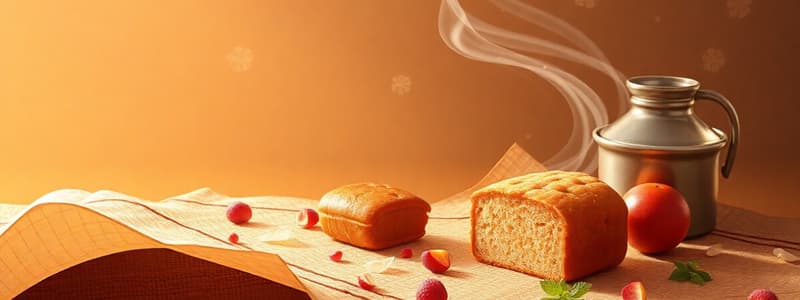Podcast
Questions and Answers
How does the method of cutting a pepper affect its culinary use?
How does the method of cutting a pepper affect its culinary use?
- It changes the nutritional value of the pepper.
- It impacts the surface area exposed. (correct)
- It alters the cooking temperature.
- It determines the color of the pepper.
Which of the following is NOT a characteristic of living organisms?
Which of the following is NOT a characteristic of living organisms?
- Respiration
- Inability to adapt (correct)
- Reproduction
- Metabolism
What does the manufacture of paper involve?
What does the manufacture of paper involve?
- Layering cloth fibers into thick sheets.
- Pelleting cellulose fibers without additives.
- Using synthetic materials to create sheets.
- Processing wood pulp, adding chemicals, and drying. (correct)
Which of the following factors can contribute to feelings of happiness?
Which of the following factors can contribute to feelings of happiness?
What characterizes the emotion of sadness?
What characterizes the emotion of sadness?
How can feelings of anger be physiologically manifested?
How can feelings of anger be physiologically manifested?
Which of these cutting techniques is specifically mentioned for peppers?
Which of these cutting techniques is specifically mentioned for peppers?
What is a common response to experiences that trigger sadness?
What is a common response to experiences that trigger sadness?
Flashcards
Cut Pepper
Cut Pepper
A pepper that has been sliced, diced, or chopped. The cut affects taste, texture, and cooking time.
Paper
Paper
A thin sheet material made from cellulose fibers from wood pulp. Different types have different thicknesses, textures, and uses.
Living
Living
The state of being alive, marked by functions like respiration, metabolism, and reproduction.
Sadness
Sadness
Signup and view all the flashcards
Happiness
Happiness
Signup and view all the flashcards
Anger
Anger
Signup and view all the flashcards
Study Notes
Cut Pepper
- A cut pepper is a pepper that has been sliced, diced, or chopped.
- The method of cutting affects the surface area exposed, impacting taste, texture, and cooking time.
- Different cutting techniques (e.g., julienning, dicing) yield different shapes and sizes, suitable for various culinary applications.
Paper
- Paper is a thin sheet material made from cellulose fibers, typically from wood pulp.
- Paper's properties include absorbency, flexibility, and strength, varying based on the manufacturing process.
- Different paper types (e.g., printer paper, construction paper) have different thicknesses, textures, and uses.
- Paper is a widely used material in writing, printing, packaging, and other applications.
- Paper manufacturing involves processing wood pulp, adding chemicals, and drying the pulp into sheets.
Living
- Living refers to the state of being alive, characterized by biological functions such as respiration, metabolism, and reproduction.
- Living organisms exhibit intricate systems for survival, growth, and adaptation.
- Examples of living things include animals, plants, fungi, and bacteria.
- Living beings adapt to their environments through natural selection and evolution, exhibiting diverse forms and functionalities.
Sad
- Sadness is a human emotion characterized by feelings of unhappiness, sorrow, or dejection.
- Sadness is a normal human response to difficult experiences or loss.
- The intensity and duration of sadness can vary greatly.
- Feelings of sadness may be linked to physical changes in the body, such as fatigue or changes in appetite.
- Sadness can be a trigger for seeking support, whether from friends, family, or professionals.
Happy
- Happiness is an emotion characterized by feelings of joy, contentment, or well-being.
- Happiness can be a fleeting feeling or a sustained state of mind.
- Factors contributing to happiness often include positive relationships, personal achievements, and a sense of purpose.
- Various practices, like mindfulness and gratitude exercises, can also foster feelings of happiness.
- Positive emotions like happiness promote overall well-being and resilience.
Mad
- "Mad" can refer to anger, fury, or extreme frustration.
- It's a strong negative emotion often triggered by perceived injustice, provocation, or unmet expectations.
- The intensity of anger varies considerably with the circumstances.
- Physiological responses to anger can include increased heart rate and adrenaline levels.
- Managing anger effectively is crucial for maintaining mental and emotional well-being.
Studying That Suits You
Use AI to generate personalized quizzes and flashcards to suit your learning preferences.




